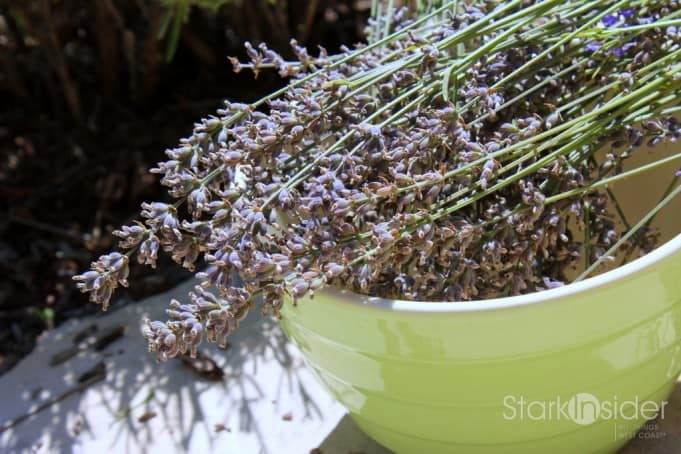The smell of lavender relaxes and makes one conjure up memories of the last luxurious day at the spa. This weekend, while checking on the tomatoes in my organic backyard vegetable garden, I just happen to look over at my lavender plants. I have about five lavender plants dotting the perimeter of my backyard. Up until that moment, they had just been plants that added texture to my garden scape and bright purple colors in the spring. Occasionally, I’ve brushed up against them and absentmindedly noticed a moment of exhilarating relaxation of the mind.
Today, I really noticed at my lavender plants and saw a grand opportunity. The lavender plants were past their peak purple color, but the flowers still had a rich, potent smell. What if I could capture the scent year round by making lavender oil?
The results have been so incredibly wonderful, I knew I had to share the process with you, dear reader. There are many ways explained online on how to do this. Of course, I think the method I am going to share with you is the best and I’ll explain why through the process.
1. Harvest the lavender flowers
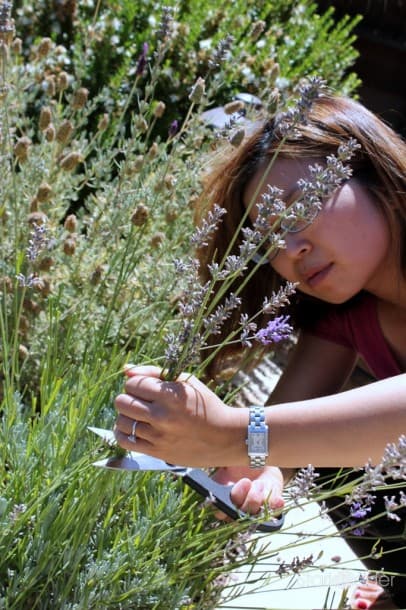
Okay, this is an obvious step but I thought I would mention it. I just used simple kitchen scissors to harvest my lavender. On lavender farms they use sickles or knives to speed up the process, but if you are talking about just a couple of plants, regular scissors work fine and are a lot safer.
Some sources tell you to harvest right at the peak of bloom when the lavender is the most intense hue. I find that the scent is just as poignant a few weeks past this peak and wait to harvest my lavender then so that I can enjoy the bright colors in my backyard before I transform the flowers into lavender oil.
2. Separate flowers from the stem
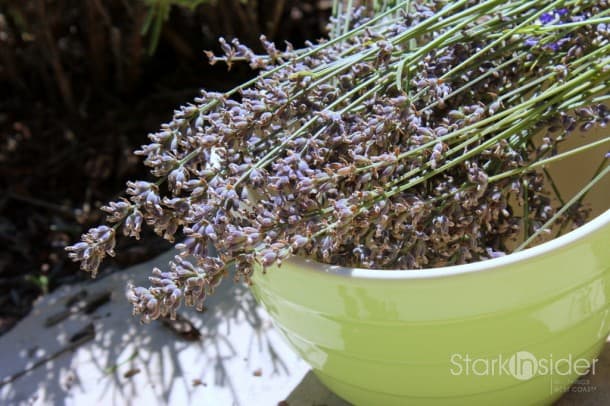
Once you have gathered all the lavender, carefully separate the flowers from the stems by using your forefinger and thumb and sliding it across each stem, starting from the base of the flowers and moving to the tip. Depending on how many stems you have, you may start developing symptoms of “rug burn”. Either rest or to have alleviate the sensation, rub some oil you will be using to make lavender oil on your fingers to reduce the friction.
3. Extracting the essence of lavender
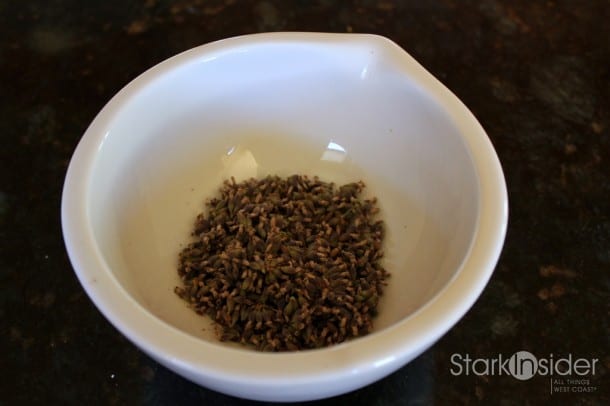
I extract the oils of lavender using what I call as a “cold pressed” method with mortar and pestle. It is a bit more work than some other methods requiring one to heat/simmer the oil and lavender in a pot which I think could damage some of the useful qualities of lavender. There are also other methods that recommend just placing the flowers and even the stems into a jar of oil and placing the enclosed jar in a warm area from 48 hours to 1 month to allow the lavender to completely infuse the oil.
I think the mortar and pestle method enables the best extraction while still protecting the positive properties of lavender.
What oil to use? I like jojoba oil of all the oils I’ve tried. Jojoba oil is a botanical extract of the seed of the jojoba tree and is the closest substance to human skin oil. It is also highly stable, non-comedogenic, and will not become rancid or lose antioxidants over time. Finally, it is easily absorbed by the skin. Since I will use my lavender oil mainly as one of the key ingredients for a massage butter I create, jojoba oil is the perfect choice.
Other oils to try include sweet almond oil, olive oil, and grape seed oil. Olive oil is an interesting choice, but I have found some drawbacks. The extra virgin olive oil is lighter consistency, but also has the most poignant scent of its own. If you like the combination of olive oil and lavender scent, then go for it. Otherwise, the regular olive oil with less scent is more viscose, which I don’t like.
Pour enough oil into the mortar to reach the top of the lavender flowers. Then use the pestle to macerate the lavender. By now, your kitchen should be filled with heavenly smell of lavender. Keep doing this for about 15-30 minutes. Then pour more oil into the mortar until you have filled it up 2/3 of the way. Cover up the mortar and let it stand for at least 48 hours or as long as you desire.
If you have several batches, pour the first batch from the mortar into a jar and repeat.

4. Straining your lavender oil
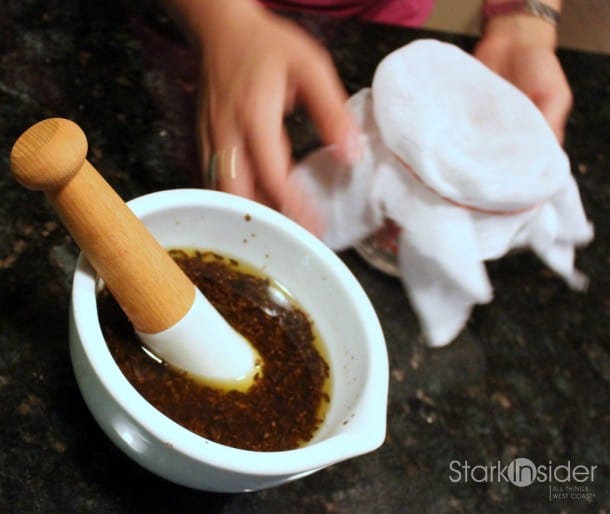
You can use a sieve as suggested by some, however, I find the best method is two layers of cheese cloth over a measuring cup, held on by an elastic band. Using a sieve, it is hard to press all the oil out of the lavender flowers. Using a cheese cloth will make it a lot easier to do this as you will see demonstrated below.
Slowly pour the mixture from the mortar through the cheese cloth.
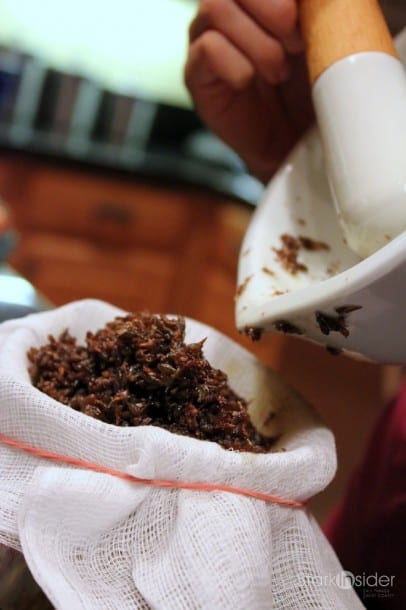
Next, carefully wrap the cheese cloth around the lavender flowers. Twist into a ball and use your hands to squeeze all the oil from the flowers. This is especially important when you are using a more expensive oil such as jojoba oil.
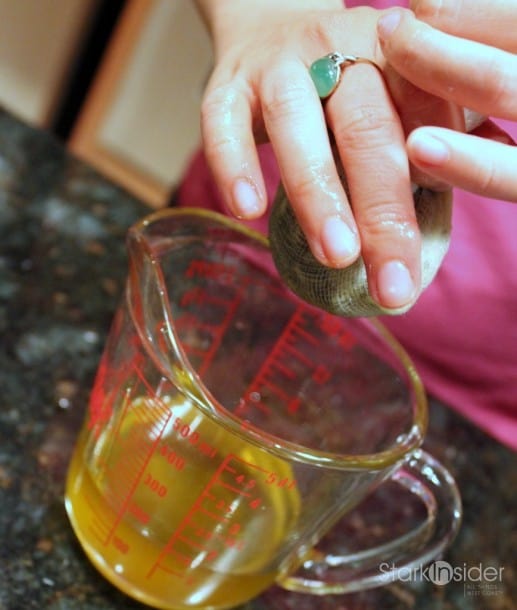
5. Store your lavender oil
Voila! You have lavender oil. It is nice to collect it in a measuring cup since it has a nice pour spout you can use to transfer it into your jar or bottle of choice. Ideally, you want the jar to be clean, made of dark glass and to have a tightly sealed lid.
There are some that suggest if you are going to store the lavender oil for months to actually freeze it. I freeze any lavender oil I don’t plan to use within the month to maintain freshness. I think this is a personal preference.
There you have it. Your very own lavender oil. What I like about making your own lavender oil is that you know exactly how it was grown, what is in it and also get to experience the joys from using something from your very own backyard.
Most of my lavender oil will go into a massage butter that I make. I’ll share my recipe for massage butter another time.

